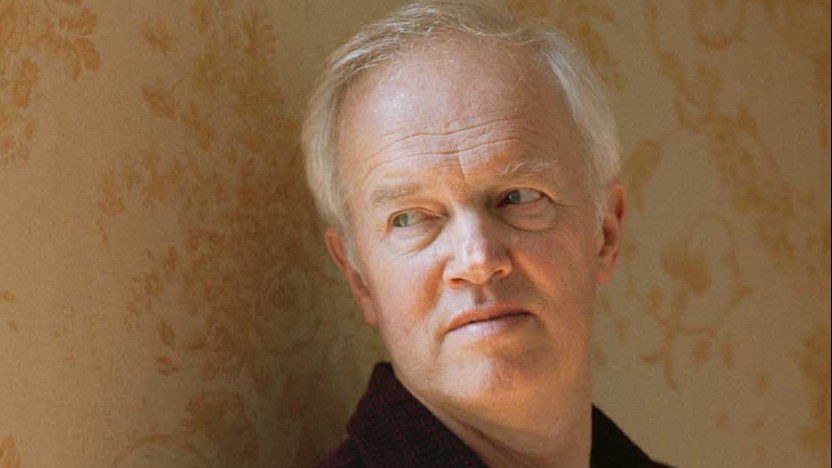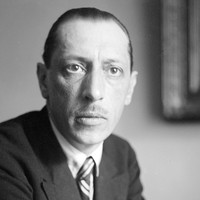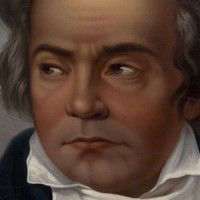Opening Night: Beethoven’s Eroica and Stravinsky

Sponsored By
- September 7, 2012

- September 8, 2012


Sponsored By



The breadth of the Russian composer Igor Stravinsky’s influence on the history of Western music is difficult to exaggerate. That he was the twentieth century’s greatest composer remains the contention of many. Living from 1882 to 1971, Stravinsky absorbed virtually every significant musical innovation of the twentieth century, from neoclassicism to serialism, each of which consequently became a part of his arsenal of compositional techniques. In his own words: “I stumble upon something unexpected. This unexpected element strikes me. I make note of it. At the proper time, I put it to profitable use.”
Stravinsky composed the Concerto in D Major for String Orchestra in 1946 on a commission from the Swiss conductor and arts patron extraordinaire Paul Sacher. Sacher, the benefactor responsible for a great many seminal masterpieces of the twentieth century (among them Bartók’s Music for Strings, Percussion, and Celesta and his Divertimento for Strings, Strauss’s Metamorphosen, and works by numerous other major composers), requested a work to commemorate the twentieth anniversary of his Basel Chamber Orchestra. The Concerto in D (also referred to as the Basle Concerto) represented Stravinsky’s first European commission following his emigration to the United States; it was completed on August 8, 1946, in Hollywood.
The concerto illustrates Stravinsky’s neoclassical style—an aesthetic, prevalent during the early twentieth century and pioneered particularly by Stravinsky, characterized by a preoccupation with the musical principles of the Classical period. Though its sound is distinctly modern, the concerto, like Stravinsky’s other neoclassical works, favors melodic and formal clarity over what composers in the early twentieth century saw as the dramatic excesses of Romanticism. The harmonic language is essentially tonal, swaying back and forth between D major and D minor. Its three-movement design (fast-slow-fast) echoes the Baroque concerto grosso, likewise its transparency of texture and piquant counterpoint. The spirited opening Vivace resembles Classical sonata form. The dulcet Arioso exhibits a Haydnesque wit in its punctuation of the violins’ lyrical melody with V-I cadences in foreign keys. The finale is a rondo—a further salute to the Classical style—but departs considerably from the eighteenth-century manners of Haydn and Mozart. The movement’s angular rhythmic character has in part lent the concerto to numerous ballet settings, including Jerome Robbins’s The Cage in 1951.
The Octet for Winds, completed in 1923, represents Stravinsky’s first essay in neoclassicism. The composer articulated the expressive goal of the work’s unconventional wind instrumentation in his 1924 article “Some Ideas about My Octour,” serving likewise to illuminate the neoclassical aesthetic: “Wind instruments seem to me to be more apt to render a certain rigidity of the form I had in mind than other instruments—the stringed instruments, for example, which are less cold and more vague.” Stravinsky further described the octet as, “not an ‘emotive’ work, but a musical composition based on elements which are sufficient in themselves.”
Like the Concerto in D Major more than two decades later, the effervescent octet relies on standard Classical forms: a sonata-form sinfonia (as, among other things, the introductory movements of Bach cantatas were typically called) followed by a theme and variations (including a fugato variation) and a concluding rondo. Stravinsky himself conducted the work’s world premiere, at the Paris Opéra, marking the first time the composer and sometime conductor led a first performance of any of his works. The octet portended a new direction for Stravinsky’s musical language that befuddled listeners. In discussing the advent of neoclassicism, Aaron Copland writes,
“Here again Igor Stravinsky led the way. The French musical world first became aware of this new tendency—referred to in the beginning as the ‘back-to-Bach’ movement—with the first performance of the Stravinsky Octet on October 18, 1923. I was in the audience on the night of its premiere…and can attest to the general feeling of mystification that followed the initial hearing. Here was Stravinsky, who had created a neoprimitive style all his own, based on native Russian sources—a style that everyone agreed was the most original in modern music—now suddenly, without any seeming explanation, making an about-face and presenting a piece to the public that bore no conceivable resemblance to the individual style with which he had hitherto been identified. Everyone was asking why Stravinsky should have exchanged his Russian heritage for what looked very much like a mess of eighteenth-century mannerisms. The whole thing seemed like a bad joke that left an unpleasant after-effect and gained Stravinsky the unanimous disapproval of the press. No one could possibly have foreseen, first, that Stravinsky was to persist in this new manner of his or, second, that the octet was destined to influence composers all over the world in bringing the latent objectivity of modern music to full consciousness by frankly adopting the ideals, forms, and textures of the pre-Romantic era.”
Patrick Castillo ©2012

The breadth of the Russian composer Igor Stravinsky’s influence on the history of Western music is difficult to exaggerate. That he was the twentieth century’s greatest composer remains the contention of many. Living from 1882 to 1971, Stravinsky absorbed virtually every significant musical innovation of the twentieth century, from neoclassicism to serialism, each of which consequently became a part of his arsenal of compositional techniques. In his own words: “I stumble upon something unexpected. This unexpected element strikes me. I make note of it. At the proper time, I put it to profitable use.”
Stravinsky composed the Concerto in D Major for String Orchestra in 1946 on a commission from the Swiss conductor and arts patron extraordinaire Paul Sacher. Sacher, the benefactor responsible for a great many seminal masterpieces of the twentieth century (among them Bartók’s Music for Strings, Percussion, and Celesta and his Divertimento for Strings, Strauss’s Metamorphosen, and works by numerous other major composers), requested a work to commemorate the twentieth anniversary of his Basel Chamber Orchestra. The Concerto in D (also referred to as the Basle Concerto) represented Stravinsky’s first European commission following his emigration to the United States; it was completed on August 8, 1946, in Hollywood.
The concerto illustrates Stravinsky’s neoclassical style—an aesthetic, prevalent during the early twentieth century and pioneered particularly by Stravinsky, characterized by a preoccupation with the musical principles of the Classical period. Though its sound is distinctly modern, the concerto, like Stravinsky’s other neoclassical works, favors melodic and formal clarity over what composers in the early twentieth century saw as the dramatic excesses of Romanticism. The harmonic language is essentially tonal, swaying back and forth between D major and D minor. Its three-movement design (fast-slow-fast) echoes the Baroque concerto grosso, likewise its transparency of texture and piquant counterpoint. The spirited opening Vivace resembles Classical sonata form. The dulcet Arioso exhibits a Haydnesque wit in its punctuation of the violins’ lyrical melody with V-I cadences in foreign keys. The finale is a rondo—a further salute to the Classical style—but departs considerably from the eighteenth-century manners of Haydn and Mozart. The movement’s angular rhythmic character has in part lent the concerto to numerous ballet settings, including Jerome Robbins’s The Cage in 1951.
The Octet for Winds, completed in 1923, represents Stravinsky’s first essay in neoclassicism. The composer articulated the expressive goal of the work’s unconventional wind instrumentation in his 1924 article “Some Ideas about My Octour,” serving likewise to illuminate the neoclassical aesthetic: “Wind instruments seem to me to be more apt to render a certain rigidity of the form I had in mind than other instruments—the stringed instruments, for example, which are less cold and more vague.” Stravinsky further described the octet as, “not an ‘emotive’ work, but a musical composition based on elements which are sufficient in themselves.”
Like the Concerto in D Major more than two decades later, the effervescent octet relies on standard Classical forms: a sonata-form sinfonia (as, among other things, the introductory movements of Bach cantatas were typically called) followed by a theme and variations (including a fugato variation) and a concluding rondo. Stravinsky himself conducted the work’s world premiere, at the Paris Opéra, marking the first time the composer and sometime conductor led a first performance of any of his works. The octet portended a new direction for Stravinsky’s musical language that befuddled listeners. In discussing the advent of neoclassicism, Aaron Copland writes,
“Here again Igor Stravinsky led the way. The French musical world first became aware of this new tendency—referred to in the beginning as the ‘back-to-Bach’ movement—with the first performance of the Stravinsky Octet on October 18, 1923. I was in the audience on the night of its premiere…and can attest to the general feeling of mystification that followed the initial hearing. Here was Stravinsky, who had created a neoprimitive style all his own, based on native Russian sources—a style that everyone agreed was the most original in modern music—now suddenly, without any seeming explanation, making an about-face and presenting a piece to the public that bore no conceivable resemblance to the individual style with which he had hitherto been identified. Everyone was asking why Stravinsky should have exchanged his Russian heritage for what looked very much like a mess of eighteenth-century mannerisms. The whole thing seemed like a bad joke that left an unpleasant after-effect and gained Stravinsky the unanimous disapproval of the press. No one could possibly have foreseen, first, that Stravinsky was to persist in this new manner of his or, second, that the octet was destined to influence composers all over the world in bringing the latent objectivity of modern music to full consciousness by frankly adopting the ideals, forms, and textures of the pre-Romantic era.”
Patrick Castillo ©2012

After writing a monumental symphony that dwarfed his two previous efforts (and those of all composers who came before him), Ludwig van Beethoven gave the Symphony No. 3 in E-flat Major the subtitle of "Bonaparte," honoring the military mastermind of Revolutionary France. But the composer’s adulation turned to disgust in 1804, when he learned that Napoleon had crowned himself Emperor; according to the student who delivered the disturbing news, Ferdinand Ries, “Beethoven went to the table, seized the top of the title-page, tore it in half and threw it on the floor.” When preparing the symphony for publication in 1806, Beethoven re-titled it "Sinfonia eroica, composed to celebrate the memory of a great man,” without specifying who that other hero was.
The defining motive of the Eroica Symphony’s first movement is a rocking cello strain that trails into foreign harmonies after four measures. As the central development section closes, a French horn makes a surprise entrance with a recapitulation of that same theme a few measures ahead of schedule — an effect so unexpected that even Beethoven’s student Ries, upon hearing the symphony for the first time, suspected the horn player of having lost count of the measures.
The symphony’s second movement, labeled a funeral march, sinks into a prolonged state of despair that might induce misery if not for its undeniable grace and beauty. A major-key interlude, providing respite, incorporates an arpeggiated accompaniment that recalls the gentle sway of the first movement. After returning to the minor key, the appearance of fugal counterpoint reinforces the profound, ceremonial atmosphere of the funeral march.
Out of this grief comes a giddy Scherzo, a symphonic construct that Beethoven popularized as an alternative to Franz Joseph Haydn’s slower, tamer minuets. A contrasting trio section features the three horns in vigorous hunting calls.
The finale, built as a theme and variations, incorporates material from the ballet The Creatures of Prometheus that Beethoven had also used in an earlier set of piano variations. A short but fiery introduction gives way to an unusual presentation of the theme, reduced to its bare skeleton.
Aaron Grad ©2024
Get driving directions and find nearby parking.
Find dining options close to the venue.
View seating charts to find out where you'll be seating.
Get driving directions and find nearby parking.
Find dining options close to the venue.
View seating charts to find out where you'll be seating.
